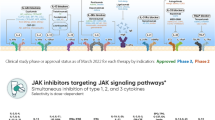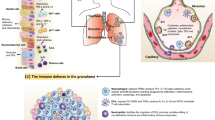Abstract
Objective and design
Interleukin (IL)-22 is important for mucosal host defense. Whereas previous studies focus on lymphocytes as sources of IL-22, we determined whether IL-22 is produced by inflammatory cells in the lungs other than T-lymphocytes during the activation of the innate immune response.
Material, methods and treatment
Inflammatory cells in the lungs of Balb/c mice were primed by endotoxin (LPS, 10 μg) or peptidoglycan (PG, 40 μg) intranasally (3 days). After CD3 + cell depletion, lung homogenates were re-stimulated 24 h with LPS (100 ng/ml), PG (10 μg/ml), IL-23 (100 ng/ml) or vehicle. Human BAL macrophages were stimulated 24 h with PG (50 μg/ml) and IL-23 (100 ng/ml) or vehicle. The release of IL-22 was measured with ELISA and intracellular IL-22 with immunostaining. For statistics, either Dunnett or Students t test method was employed (n = 3–8).
Results
Re-stimulation in vitro increased concentrations of mouse IL-22 protein irrespective of priming in vivo. A majority of macrophages in mouse lung and BAL samples displayed immunostaining for IL-22. In analogy, human BAL macrophages released IL-22 protein, and a third of these cells displayed immunostaining for IL-22.
Conclusions
Alveolar macrophages can produce and release IL-22 during the activation of the innate immune response and thereby constitute a potentially important regulator of mucosal host defence in the lungs.





Similar content being viewed by others
References
Wolk K, Witte E, Wallace E, Döcke W-D, Kunz S, Asadullah K, et al. IL-22 regulates the expression of genes responsible for antimicrobial defense, cellular differentiation, and mobility in keratinocytes: a potential role in psoriasis. Eur J Immunol. 2006;36(5):1309–23.
Andoh A, Zhang Z, Inatomi O, Fujino S, Deguchi Y, Araki Y, et al. Interleukin-22, a member of the IL-10 subfamily, induces inflammatory responses in colonic subepithelial myofibroblasts. Gastroenterology. 2005;129(3):969–84.
Whittington HA, Armstrong L, Uppington KM, Millar AB. Interleukin-22: a potential immunomodulatory molecule in the lung. Am J Respir Cell Mol Biol. 2004;31(2):220–6.
Wolk K, Kunz S, Witte E, Friedrich M, Asadullah K, Sabat R. IL-22 increases the innate immunity of tissues. Immunity. 2004;21(2):241–54.
Zheng Y, Valdez PA, Danilenko DM, Hu Y, Sa SM, Gong Q, et al. Interleukin-22 mediates early host defense against attaching and effacing bacterial pathogens. Nat Med. 2008;14(3):282–9.
Aujla SJ, Chan YR, Zheng M, Fei M, Askew DJ, Pociask DA, et al. IL-22 mediates mucosal host defense against Gram-negative bacterial pneumonia. Nat Med. 2008;14(3):275–81.
Ota N, Wong K, Valdez PA, Zheng Y, Crellin NK, Diehl L, et al. IL-22 bridges the lymphotoxin pathway with the maintenance of colonic lymphoid structures during infection with Citrobacter rodentium. Nat Immunol. 2011;12(10):941–8.
Weber GF, Schlautkötter S, Kaiser-Moore S, Altmayr F, Holzmann B, Weighardt H. Inhibition of Interleukin-22 attenuates bacterial load and organ failure during acute polymicrobial sepsis. Infect Immun. 2007;75(4):1690–7.
Scriba TJ, Kalsdorf B, Abrahams D-A, Isaacs F, Hofmeister J, Black G, et al. Distinct, specific IL-17- and IL-22-producing CD4 + T cell subsets contribute to the human anti-mycobacterial immune response. J Immunol. 2008;180(3):1962–70.
Glader P, Smith M, Malmhäll C, Balder B, Sjöstrand M, Qvarfordt I, et al. Interleukin-17-producing T-helper cells and related cytokines in human airways exposed to endotoxin. Eur Respir J. 2010;36(5):1155–64.
Liang SC, Tan X-Y, Luxenberg DP, Karim R, Dunussi-Joannopoulos K, Collins M, et al. Interleukin (IL)-22 and IL-17 are coexpressed by Th17 cells and cooperatively enhance expression of antimicrobial peptides. J Exp Med. 2006;203(10):2271–9.
Zheng Y, Danilenko DM, Valdez P, Kasman I, Eastham-Anderson J, Wu J, Ouyang W. Interleukin-22, a T(H)17 cytokine, mediates IL-23-induced dermal inflammation and acanthosis. Nature. 2007;445:648–51.
Ikeuchi H, Kuroiwa T, Hiramatsu N, Kaneko Y, Hiromura K, Ueki K, et al. Expression of interleukin-22 in rheumatoid arthritis: potential role as a proinflammatory cytokine. Arthritis Rheum. 2005;52(4):1037–46.
Bosmann M, Sarma JV, Atefi G, Zetoune FS, Ward PA. Evidence for anti-inflammatory effects of C5a on the innate IL-17A/IL-23 axis. FASEB J. 2012;26(4):1640–51.
Brentano F, Ospelt C, Stanczyk J, Gay RE, Gay S, Kyburz D. Abundant expression of the interleukin (IL) 23 subunit p19, but low levels of bioactive IL23 in the rheumatoid synovium: differential expression and toll-like receptor-(TLR) dependent regulation of the IL23 subunits, p19 and p40, in rheumatoid arthritis. Ann Rheum Dis. 2009;68(1):143–50.
Paradowska-Gorycka A, Grzybowska-Kowalczyk A, Wojtecka-Lukasik E, Maslinski S. IL-23 in the pathogenesis of rheumatoid arthritis. Scand J Immunol. 2010;71(3):134–45.
Ivanov S, Bozinovski S, Bossios A, Valadi H, Vlahos R, Malmhäll C, et al. Functional relevance of the IL-23–IL-17 axis in lungs in vivo. Am J Respir Cell Mol Biol. 2007;36(4):442–51.
Hume DA, Ross IL, Himes SR, Sasmono RT, Wells CA, Ravasi T. The mononuclear phagocyte system revisited. J Leukoc Biol. 2002;72(4):621–7.
Khazen W, M’Bika J-P, Tomkiewicz CL, Benelli C, Chany C, Achour A, et al. Expression of macrophage-selective markers in human and rodent adipocytes. FEBS Lett. 2005;579(25):5631–4.
McKnight AJ, Macfarlane AJ, Dri P, Turley L, Willis AC, Gordon S. Molecular cloning of F4/80, a murine macrophage-restricted cell surface glycoprotein with homology to the G-protein-linked transmembrane 7 hormone receptor family. J Biol Chem. 1996;271(1):486–9.
Austyn JM, Gordon S. F4/80, a monoclonal antibody directed specifically against the mouse macrophage. Eur J Immunol. 1981;11(10):805–15.
Pollard AM, Lipscomb MF. Characterization of murine lung dendritic cells: similarities to Langerhans cells and thymic dendritic cells. J Exp Med. 1990;172(1):159–67.
Vermaelen K, Pauwels R. Accurate and simple discrimination of mouse pulmonary dendritic cell and macrophage populations by flow cytometry: methodology and new insights. Cytom Part A. 2004;61A(2):170–7.
Gonzalez-Juarrero M, Orme IM. Characterization of murine lung dendritic cells infected with mycobacterium tuberculosis. Infect Immun. 2001;69(2):1127–33.
Miravitlles M. Exacerbations of chronic obstructive pulmonary disease: when are bacteria important? Eur Respir J. 2002;20(36):9–19.
Johansen H, Gøtzsche P. Vaccines for preventing infection with Pseudomonas aeruginosa in cystic fibrosis. Cochrane Database Syst Rev. 2008;8:4.
Wolk K, Kunz S, Asadullah K, Sabat R. Cutting edge: immune cells as sources and targets of the IL-10 family members? J Immunol. 2002;168(11):5397–402.
Pirhonen J, Matikainen S, Julkunen I. Regulation of virus-induced IL-12 and IL-23 expression in human macrophages. J Immunol. 2002;169(10):5673–8.
Acknowledgments
The authors would like to thank Margaretha Smith, M.D., Helga Asgeirsdóttir, M.D., Åke Alfredsson, B.Sci., and Monika Crona, B.Sci., for technical assistance with the collection of the human BAL samples. This work was supported by the Swedish Heart–Lung Foundation (Grant Number 20070421), federal funding according to the ALF/LUA agreement, the Swedish Science Council (Grant Number K2008-57X-09048-19-3), King Gustav V’s and Queen Victoria’s Freemason Research Fund and Federal Funding at the Karolinska Institute.
Author information
Authors and Affiliations
Corresponding author
Additional information
Responsible Editor: Graham Wallace.
Electronic supplementary material
Below is the link to the electronic supplementary material.
11_2013_608_MOESM1_ESM.pdf
Supporting material 1 Detection of immunostaining for IL-22 in CD3-depleted lung cells harvested from Balb/c mice exposed to PG (40 μg) for three consecutive days, and stimulated in vitro with IL-23 (100 ng/ml). Macrophages with positive immunostaining for F4/80 repeatedly showed immunostaining for IL-22 as well (n=3). Pictures show a typical result of double-staining for IL-22 and F4/80, single staining for IL-22 and F4/80, respectively, and isotype control antibody staining for both antibodies in 100x magnification (A) and 20x magnification (B) (PDF 554 kb)
11_2013_608_MOESM2_ESM.pdf
Supporting material 2 Detection of immunostaining for IL-22 in lung cells harvested from Balb/c mice exposed to PG (40 μg) for three consecutive days. Macrophages with positive immunostaining for F4/80 repeatedly showed immunostaining for IL-22 as well (n=3). Pictures show a typical result of double-staining for IL-22 and F4/80, single staining for IL-22 and F4/80, respectively, and isotype control antibody staining for both antibodies in 100x magnification (A) and 20x magnification (B) (PDF 566 kb)
11_2013_608_MOESM3_ESM.pdf
Supporting material 3 Detection of immunostaining for IL-22 in lung cells harvested from Balb/c mice exposed to PBS (vehicle) for three consecutive days. Macrophages with positive immunostaining for F4/80 repeatedly showed immunostaining for IL-22 as well (n=3). Pictures show a typical result of double-staining for IL-22 and F4/80, single staining for IL-22 and F4/80, respectively, and isotype control antibody staining for both antibodies in 100x magnification (A) and 20x magnification (B) (PDF 693 kb)
Rights and permissions
About this article
Cite this article
Hansson, M., Silverpil, E., Lindén, A. et al. Interleukin-22 produced by alveolar macrophages during activation of the innate immune response. Inflamm. Res. 62, 561–569 (2013). https://doi.org/10.1007/s00011-013-0608-1
Received:
Revised:
Accepted:
Published:
Issue Date:
DOI: https://doi.org/10.1007/s00011-013-0608-1




